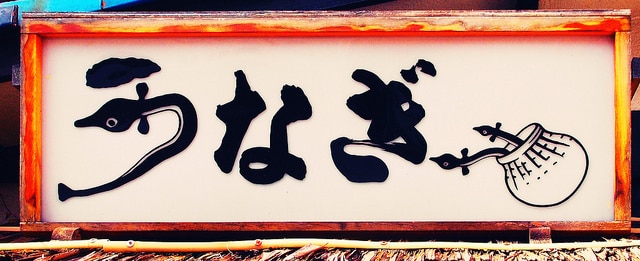
Get to Know Eels! Eel Day in Japan
The arrival of summer in Japan has brought with it a sweltering heat. In Tokyo, the heat accumulates in the concrete jungle and the humidity feels like it has reached over 100%. Even everyday tasks take tremendous effort in the summer. Many Japanese people lose their appetites in this overwhelming heat. During this exhausting time, Japanese culture has a tradition to prepare dishes with eel. In fact, this year both July 25th and August 6 will be Eel Days* called Doyo no Ushi no Hi in Japan. Supermarkets, restaurants, cafeterias, fast food restaurants, and even convenience stores are selling eel dishes. You are probably wondering, why is Japan over consuming this endangered species?
Typical うなぎ “Unagi(eel)” sign. How many eels can you spot? Photo by Ray Larabie.
Mastering Eel Cooking
The history of eel eating culture reaches back thousands of years. Archaeologists in Japan found eel bones in prehistoric sites dating back 5000 years; one of the oldest books, published in 7th century, includes a haiku about eels. Traditionally, eel was only served at specialized restaurants. An old proverb says that “it takes 3 years to master skewering, 5 years to master grilling, and flavoring is a lifelong journey.” This masterpiece eel is served on rice, called Unaju, and often served with eel heart soup. Such meal was only served at special occasions, and considered a delicacy.

Traditional Unaju. Photo by OiMax
Summer and Eel
Why summer? There are many theories about how this summer Eel Day tradition started even though the best eel season is winter. In the Edo period, land reclamation was carried out in many places, and throughout the process, many eels were caught due to habitat loss. Eel was on the market year around and restaurants needed good advertising line to sell eel in the summer. One eel chef asked Gennai Hiraga, known as the da Vinci of Japan, if he had any good ideas.
Gennai created a marketing scheme that was so successful that people still think eel season takes place in summer 250 years later. Combined with the fact that eel is high in protein and vitamins, as well as being easy to digest, eel became the perfect energy restoring summertime food.
Over Advertising
We cannot blame Gennai for his outstanding marketing skills. For a long time, the life cycle of eel was unknown. Eel larvae was caught and sold to farms without regulations. Japan is the biggest eel importing country and imported eel are often used in the low-end market, commonly found in lower-priced convenience stores and fast food restaurants. It is hard to believe that eel is an endangered species when it is sold for such a reasonable price at so many places. In fact, a survey showed that even though 67.8% of people know that eel is endangered, 69.7% of people still said that they will eat eel on Eel Day in Japan.
Additionally, the media encourages society to eat eel on Eel Day as a summertime tradition, creating competition in the market and causing prices to drop. Even worse, the media has been urging consumers to eat eel this summer as we might not be able to enjoy this scarce resource in the near future. The meaning of the tradition needs to be revisited if the price and value of eel are not properly valued in the market and cause drastic damage in the global eel resource.
Eel market. Photo by Kent Wang.
No Eel, What’s Next?
One of the biggest retailers in Japan, AEON, has been working on an interesting project. AEON has been selling “eel flavored catfish” on Eel Day in past few years. The fake eel is cooked in a special sauce which gives catfish an eel-like flavor. This is a great way to raise awareness and we strongly encourage consumers to try this alternative eel option on Eel Day to enjoy the summer tradition responsibly.
A recent study showed that 45% to 75% of imported Chinese eel product in Japanese markets were found to be illegally harvested. Given that 75% of the global eel catch ends up in Japan, this is a serious social responsibility issue.
The future of Eel Day is up to us. We encourage all retailers to develop a robust transparent traceability system for all eel products and communicate clearly with consumers. In the complicated eel supply chain, companies need to collaborate and tackle this issue together.
*The date of Eel day(s) changes every year according to the Japanese seasonal calendar.
references:
Pramod, G., Pitcherb, T., Mantha, G. (2017) Estimates of illegal and unreported seafood imports to Japan. Marine Policy. 84: 42-51. Available at: http://www.sciencedirect.com/science/article/pii/S0308597X17300817
HoNote (2017) 今年は2日間!土用の丑の日に関する調査. Available at: https://www.macromill.com/honote/20170613/report.html







